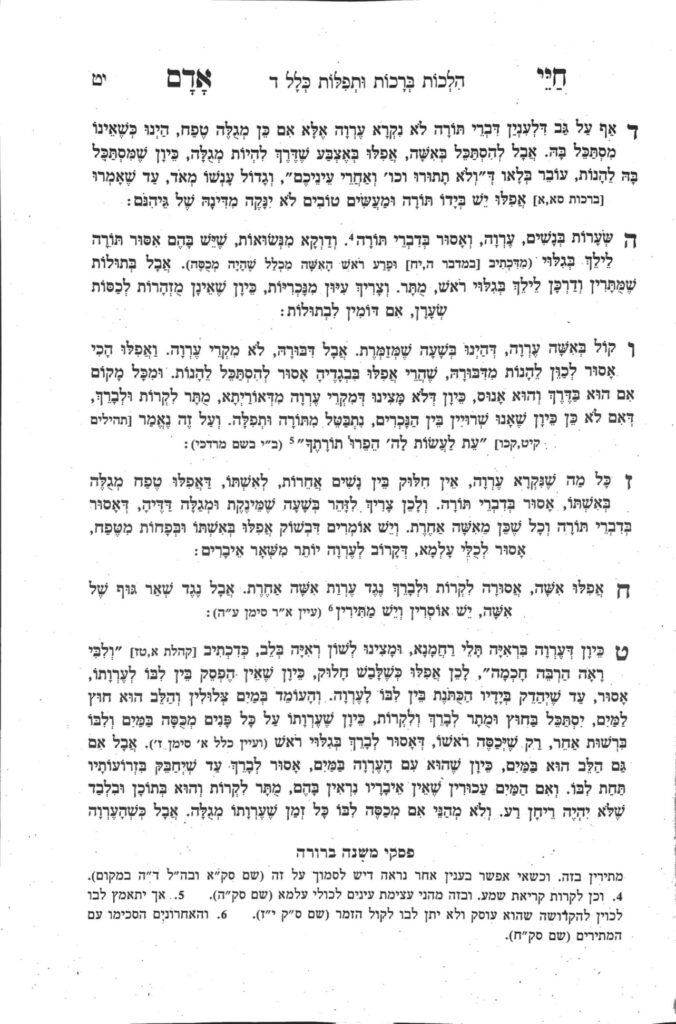We are continuing in siman 5, discussing the halachos of covering hair. We have discussed the opinion of Tosfos regarding the places and situations in which a married woman must cover her hair. Today, we will discuss the opinion of the Rambam.
The Rambam can be found in Hilchos Ishus, 24:11-12. In halacha 11, the Rambam writes that an example of a woman who is not following das Moshe, the Torah, is a woman who goes out to the main thoroughfare with her hair uncovered. If a woman does so, she forfeits her right to receive a kesuva payment. In halacha 12, He defines das yehudis as customs of tznius that jewish women have undertaken upon which Chazal have placed their imprimatur. The Rambam then lists the following examples as places in which a woman must cover her hair due to das yehudis: the shuk, and a mavui which opens on both ends, so others use it to travel between primary roads. He writes that if a woman goes out without a redid, even if she is wearing a mitpachas, since she is not wearing two layers of covering, she transgresses das yehudis. The Rambam understands that mideoraysa a mitpachas is sufficient, and understands a mitpachas as equivalent to the kalsah of the gemara. However, he understands that the redid, as second covering, will also be necessary even in a mavui. Clearly, the second covering comes to add coverage not provided by the first covering, which leads us to understand that the Rambam holds that even in the mavui, a woman must fully cover her hair.
On this halacha, the Hagahos Maymonis adds from the Yerushalmi that there is a type of chatzer which is similar to a mavui, and a type of mavui which is similar to a chatzer. A chatzer which is frequented by people is considered a mavui, and a mavui which is not frequented is considered a chatzer. The Rambam never clarifies the halacha regarding a chatzer, but seems to understand that whereas places with significant volumes of people require two layers of covering, places with less traffic require one layer, but that one layer is necessary (as opposed to Tosfos who holds no covering is needed).
The above is the understanding of the Bach, Siman 75, as quoted by the Biur Halacha we mentioned yesterday. After discussing the tzimtan, he quotes the Magen Avraham that a chatzer in which people do not frequent, a woman can keep her hair uncovered. He then quotes the Zohar, which says otherwise. The Biur Halacha points out that this discussion is only regarding the halachic responsibility for a married woman to cover her hair, as regarding, devarim shebikdedusha, it will certainly be assur to recite devarim shebikedusha if her hair is uncovered.
The Biur Halacha continues, and writes that the Bach understands theRambam that das yehudis is that hair should remain covered in all places, even in one’s home (we will need to discuss whether it means a full covering). He then adds that, even if it is not an issue to the point that she would forfeit her kesubah, it is still assur, as it transgresses das yehudis.
Many people quote that there are poskim who allow a woman to uncover her hair in the house or in the chatzer. Although we see there is such an opinion, one must be aware it is a big machlokes. The Biur Halacha then quotes the Chasam Sofer, who says the halachic standard has become to follow the Zohar, as we learned previously (shiur 1545). The Mishnah Berurah adds the Gemara in Yoma, which says that Kimchis had many children who were zoche to serve as kohanim gedolim because she was careful to keep her hair covered properly.
Summary
According to the Rambam, as understood by the Bach, das yehudis is that a woman must keep her hair covered in any place which has minimal traffic. Furthermore, the Bach understands the Rambam that das yehudis includes for a woman to cover her hair in all places, even when home.



